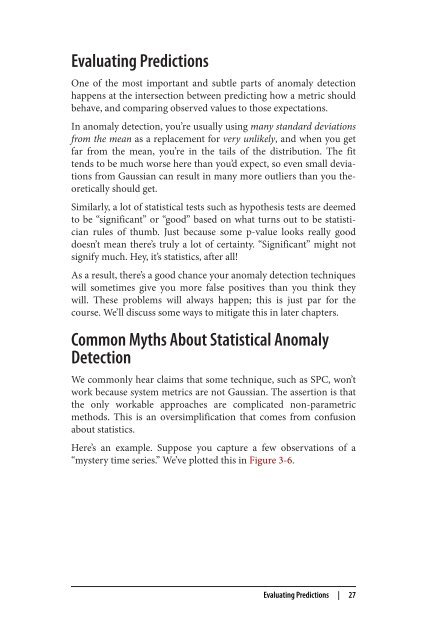Anomaly Detection for Monitoring
anomaly-detection-monitoring
anomaly-detection-monitoring
Create successful ePaper yourself
Turn your PDF publications into a flip-book with our unique Google optimized e-Paper software.
Evaluating Predictions<br />
One of the most important and subtle parts of anomaly detection<br />
happens at the intersection between predicting how a metric should<br />
behave, and comparing observed values to those expectations.<br />
In anomaly detection, you’re usually using many standard deviations<br />
from the mean as a replacement <strong>for</strong> very unlikely, and when you get<br />
far from the mean, you’re in the tails of the distribution. The fit<br />
tends to be much worse here than you’d expect, so even small deviations<br />
from Gaussian can result in many more outliers than you theoretically<br />
should get.<br />
Similarly, a lot of statistical tests such as hypothesis tests are deemed<br />
to be “significant” or “good” based on what turns out to be statistician<br />
rules of thumb. Just because some p-value looks really good<br />
doesn’t mean there’s truly a lot of certainty. “Significant” might not<br />
signify much. Hey, it’s statistics, after all!<br />
As a result, there’s a good chance your anomaly detection techniques<br />
will sometimes give you more false positives than you think they<br />
will. These problems will always happen; this is just par <strong>for</strong> the<br />
course. We’ll discuss some ways to mitigate this in later chapters.<br />
Common Myths About Statistical <strong>Anomaly</strong><br />
<strong>Detection</strong><br />
We commonly hear claims that some technique, such as SPC, won’t<br />
work because system metrics are not Gaussian. The assertion is that<br />
the only workable approaches are complicated non-parametric<br />
methods. This is an oversimplification that comes from confusion<br />
about statistics.<br />
Here’s an example. Suppose you capture a few observations of a<br />
“mystery time series.” We’ve plotted this in Figure 3-6.<br />
Evaluating Predictions | 27




